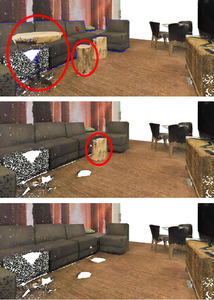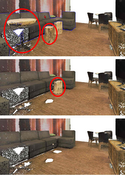Information
- Publication Type: Journal Paper with Conference Talk
- Workgroup(s)/Project(s):
- Date: September 2021
- Journal: The Visual Computer Journal
- Volume: 37
- Open Access: yes
- Location: online
- Lecturer: Mohamed Radwan
- ISSN: 1432-2315
- Event: Computer Graphics International 2021
- DOI: 10.1007/s00371-021-02243-x
- Call for Papers: Call for Paper
- Booktitle: The Visual Computer
- Pages: 13
- Publisher: Springer
- Conference date: 6. September 2021 – 10. September 2021
- Pages: 2769 – 2781
- Keywords: Software, Computer Graphics and Computer-Aided Design, Computer Vision and Pattern Recognition
Abstract
Large-scale unstructured point cloud scenes can be quickly visualized without prior reconstruction by utilizing levels-of-detail structures to load an appropriate subset from out-of-core storage for rendering the current view. However, as soon as we need structures within the point cloud, e.g., for interactions between objects, the construction of state-of-the-art data structures requires O(NlogN) time for N points, which is not feasible in real time for millions of points that are possibly updated in each frame. Therefore, we propose to use a surface representation structure which trades off the (here negligible) disadvantage of single-frame use for both output-dominated and near-linear construction time in practice, exploiting the inherent 2D property of sampled surfaces in 3D. This structure tightly encompasses the assumed surface of unstructured points in a set of bounding depth intervals for each cell of a discrete 2D grid. The sorted depth samples in the structure permit fast surface queries, and on top of that an occlusion graph for the scene comes almost for free. This graph enables novel real-time user operations such as revealing partially occluded objects, or scrolling through layers of occluding objects, e.g., walls in a building. As an example application we showcase a 3D scene exploration framework that enables fast, more sophisticated interactions with point clouds rendered in real time.Additional Files and Images
Weblinks
- https://rdcu.be/ctQay
- Entry in reposiTUm (TU Wien Publication Database)
- Entry in the publication database of TU-Wien
- DOI: 10.1007/s00371-021-02243-x
BibTeX
@article{Radwan_2021_Occ,
title = "Fast occlusion-based point cloud exploration",
author = "Mohamed Radwan and Stefan Ohrhallinger and Michael Wimmer",
year = "2021",
abstract = "Large-scale unstructured point cloud scenes can be quickly
visualized without prior reconstruction by utilizing
levels-of-detail structures to load an appropriate subset
from out-of-core storage for rendering the current view.
However, as soon as we need structures within the point
cloud, e.g., for interactions between objects, the
construction of state-of-the-art data structures requires
O(NlogN) time for N points, which is not feasible in real
time for millions of points that are possibly updated in
each frame. Therefore, we propose to use a surface
representation structure which trades off the (here
negligible) disadvantage of single-frame use for both
output-dominated and near-linear construction time in
practice, exploiting the inherent 2D property of sampled
surfaces in 3D. This structure tightly encompasses the
assumed surface of unstructured points in a set of bounding
depth intervals for each cell of a discrete 2D grid. The
sorted depth samples in the structure permit fast surface
queries, and on top of that an occlusion graph for the scene
comes almost for free. This graph enables novel real-time
user operations such as revealing partially occluded
objects, or scrolling through layers of occluding objects,
e.g., walls in a building. As an example application we
showcase a 3D scene exploration framework that enables fast,
more sophisticated interactions with point clouds rendered
in real time.",
month = sep,
journal = "The Visual Computer Journal",
volume = "37",
issn = "1432-2315",
doi = "10.1007/s00371-021-02243-x",
booktitle = "The Visual Computer",
pages = "13",
publisher = "Springer",
pages = "2769--2781",
keywords = "Software, Computer Graphics and Computer-Aided Design,
Computer Vision and Pattern Recognition",
URL = "https://www.cg.tuwien.ac.at/research/publications/2021/Radwan_2021_Occ/",
}


 paper
paper
